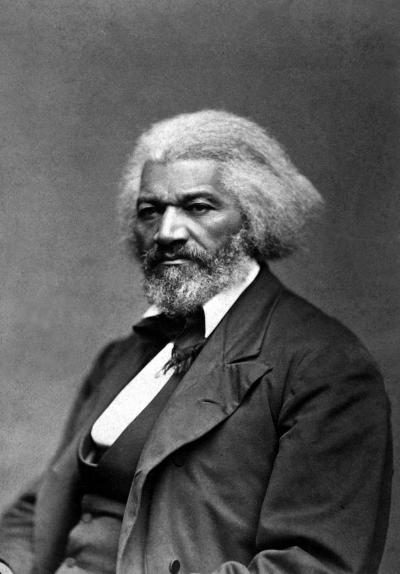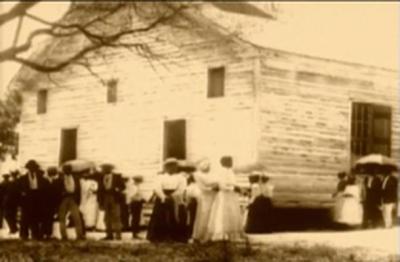“Do Nothing with Us!” African-American Integration during Reconstruction
This complete module with all materials may be downloaded as PDF here.
Jeremy Henderson
Center for Creative Arts
Chattanooga, Tennessee
This module was developed and utilized in an eighth-grade American history class in order to meet state U.S. history standards on slavery and Reconstruction. However, the module is applicable to middle and high school American history courses elsewhere.
The inspiration for this module comes from a lecture by Peter Myers titled âFrederick Douglass, Martin Luther King Jr., and Integration.â
Estimated module length: Two and half hours

Frederick Douglass. Source: Wikipedia at https://tinyurl.com/pk5xljn.

Meeting of the Committee of Freedmen, Edisto Island. Source: PBS Learning Media at https://tinyurl.com/ybxwsh7w.
Objectives
Students will:
Predict and hypothesize factors that changed the status of a people who formally constituted a subservient group in American life.
Analyze a speech by abolitionist Frederick Douglass given at the end of the Civil War.
Investigate the ways in which restrictions were placed on freedmen during the Reconstruction era.
Prerequisite knowledge
This lesson assumes students have completed a unit of study on the causes of the Civil War and the warâs subsequent course of events. Students should also have some prior knowledge of Frederick Douglass.
Module introduction
Note: All primary source material and accompanying questions are included in Appendix I of the module and at this link.
Warmup/opener (estimated time, fifteen minutes)
Teachers should distribute (or project) the chart below showing population data of the South. Ask students:
What stands out about these figures?
Based on this data, what challenges and issues do you see the South will face during Reconstruction?
How do you think the U.S. government could implement laws to aid in the integration of the nearly four million former slaves in society after the Civil War?
Population of the South 1790-1860 by type
|
Year |
White |
Free Nonwhite |
Slave |
|
1790 |
1,240,454 |
32,523 |
654,121 |
|
1800 |
1,691,892 |
61,575 |
851,532 |
|
1810 |
2,118,144 |
97,284 |
1,103,700 |
|
1820 |
2,867,454 |
130,487 |
1,509,904 |
|
1830 |
3,614,600 |
175,074 |
1,983,860 |
|
1840 |
4,601,873 |
207,214 |
2,481,390 |
|
1850 |
6,184,477 |
235,821 |
3,200,364 |
|
1860 |
8,036,700 |
253,082 |
3,950,511 |
Source: Historical Statistics of the U.S., 1970, https://eh.net/encyclopedia/slavery-in-the-united-states/
Student primary source work
Students should read and analyze the four documents provided. The teacher may choose to have students write summary statements for each document or answer the analysis questions. As the first three documents are similar in length, teachers may choose to divide this task into three parts by putting students into reading groups of three. Then, all students will analyze the fourth document, which is a political cartoon (estimated time for reading and questions, fifty minutes if completed individually or twenty minutes if assigned in groups).
Note: Original spelling is retained for this document and all that follow.
What the Black Man Wants, Frederick Douglass, 1865
Context: Frederick Douglass (1818â1895) was born a slave and became an eminent author, publisher, and antislavery advocate. Douglass became the first African-American to hold a high position in the federal government. For an excellent succinct documentary of the life of Douglass, visit https://www.biography.com/people/frederick-douglass-9278324.
Committee of Freedmen on Edisto Island, South Carolina, to the Freedmen's Bureau Commissioner; the Commissioner's Reply; and the Committee to the President, Edisto Island, South Carolina, October 20 or 21, 1865
Context: A Freedmenâs Bureau official had redistributed land from white owners to their former slaves earlier in 1865. President Andrew Johnson reversed this decision. General Oliver Howard, a supporter of the slaves' rights to keep their new land and head of the Freedmenâs Bureau, was sent to the island to announce the presidentâs reversal of the decision; the former slavesâ petition failed and the previous white owners reclaimed their land. Students and instructors may want to watch the following educational video before or after discussing the primary source excerpt:
https://nm.pbslearningmedia.org/resource/bf10.socst.us.indust.edisto/edisto-island/
Mississippi Black Codes (1865)
Context: The Black Codes were laws southern states passed shortly after the Civil War intended to restrict the civil rights and economic freedom of former slaves.
The Freedman's Bureau! political cartoon, 1866
One in a series of racist posters attacking Radical Republicans on the issue of black suffrage, issued during the Pennsylvania gubernatorial election of 1866. (See also "The Constitutional Amendment!," no. 1866-5.) The series advocates the election of Hiester Clymer, who ran for governor on a white-supremacy platform, supporting President Andrew Johnson's Reconstruction policies.
Teacher should lead whole-class discussion based on responses to analysis questions (estimated time, thirty minutes).
Closing
Watch this 7 minute 28 seconds excerpt titled, âSlavery Without the Chainâ available at https://youtu.be/vg7f-M_wNd4 from the longer PBS documentary âReconstruction: The Second Civil War.â
Students may write and/or discuss the following questions:
After watching this excerpt, paraphrase, based upon evidence from the video clip, the general attitude of northern and southern whites regarding freedmen.
Based upon the video clip, explain the new economic situation many freedmen faced.
(estimated time of video and discussion, twenty minutes)
Culminating Task
Describe freedom for former slaves as described by Douglass. How does his vision compare to what happened in the years following the Civil War? Use evidence from primary sources and video (estimated time, thirty minutes).
Assessment
Teachers should feel free to use a rubric of their choice to assess the writing task, or they may use the one below from the University of North Carolina School of Education:
References and Resources
https://eh.net/encyclopedia/slavery-in-the-united-states/: This site contains data for warmup activity and discussion of slave population.
http://teachingamericanhistory.org/library/document/what-the-black-man-wants/: Student handout No. 1, "What the Black Man Wants: by Frederick Douglass, is available here.
https://www.biography.com/people/frederick-douglass-9278324: This is the entry on Douglass from Biography.com.
https://tinyurl.com/ybxwsh7w: This is a video about the Committee of Freedmen on Edisto Island from PBS Learning Mediaâs âThe Rise and Fall of Jim Crow.â
http://www.freedmen.umd.edu/Edisto%20petitions.htm: Student handout No. 2, "Committee of Freedmen on Edisto Island, South Carolina, to the Freedmen's Bureau Commissioner; the Commissioner's Reply; and the Committee to the President," is available here.
https://www.facinghistory.org/reconstruction-era/mississippi-black-codes-1865: Student handout No. 3, "Mississippi Black Codes," is available here.
http://www.loc.gov/pictures/item/2008661698/: Student handout No. 4, The Freedman's Bureau political cartoon, is available here.
https://youtu.be/vg7f-M_wNd4: This is the PBS video on U.S. Reconstruction, available on YouTube.
https://tinyurl.com/yblpcdq3: History Essay Writing Rubric from UNC School of Education. Optional rubric for culminating task.
Note: The resources below were not directly used in the module but may be useful for teachers.
http://www.digitalhistory.uh.edu/exhibits/reconstruction/section1/section1_intro.html: This site contains excellent background readings on Reconstruction.
http://lincolnmullen.com/projects/slavery/: This is an interesting animated map showing the growth and spread of slavery using census data. It may complement discussion during warmup segment of lesson.
http://www.smithsonianmag.com/history/maps-reveal-slavery-expanded-across-united-states-180951452/: This article elaborates and explains the animated map above.